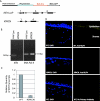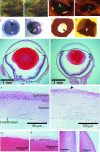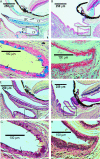Conditional deletion of the mouse Klf4 gene results in corneal epithelial fragility, stromal edema, and loss of conjunctival goblet cells
- PMID: 17060454
- PMCID: PMC1800665
- DOI: 10.1128/MCB.00846-06
Conditional deletion of the mouse Klf4 gene results in corneal epithelial fragility, stromal edema, and loss of conjunctival goblet cells
Abstract
The Krüppel-like transcription factor KLF4 is among the most highly expressed transcription factors in the mouse cornea (B. Norman, J. Davis, and J. Piatigorsky, Investig. Ophthalmol. Vis. Sci. 45:429-440, 2004). Here, we deleted the Klf4 gene selectively in the surface ectoderm-derived structures of the eye (cornea, conjunctiva, eyelids, and lens) by mating Klf4-LoxP mice (J. P. Katz, N. Perreault, B. G. Goldstein, C. S. Lee, P. A. Labosky, V. W. Yang, and K. H. Kaestner, Development 129:2619-2628, 2002) with Le-Cre mice (R. Ashery-Padan, T. Marquardt, X. Zhou, and P. Gruss, Genes Dev. 14:2701-2711, 2000). Klf4 conditional null (Klf4CN) embryos developed normally, and the adult mice were viable and fertile. Unlike the wild type, the Klf4CN cornea consisted of three to four epithelial cell layers; swollen, vacuolated basal epithelial and endothelial cells; and edematous stroma. The conjunctiva lacked goblet cells, and the anterior cortical lens was vacuolated in Klf4CN mice. Excessive cell sloughing resulted in fewer epithelial cell layers in spite of increased cell proliferation at the Klf4CN ocular surface. Expression of the keratin-12 and aquaporin-5 genes was downregulated, consistent with the Klf4CN corneal epithelial fragility and stromal edema, respectively. These observations provide new insights into the role of KLF4 in postnatal maturation and maintenance of the ocular surface and suggest that the Klf4CN mouse is a useful model for investigating ocular surface pathologies such as dry eye, Meesmann's dystrophy, and Steven's-Johnson syndrome.
Figures








References
-
- Adhikary, G., J. F. Crish, F. Bone, R. Gopalakrishnan, J. Lass, and R. L. Eckert. 2005. An involucrin promoter AP1 transcription factor binding site is required for expression of involucrin in the corneal epithelium in vivo. Investig. Ophthalmol. Vis. Sci. 46:1219-1227. - PubMed
-
- Adhikary, G., J. F. Crish, R. Gopalakrishnan, F. Bone, and R. L. Eckert. 2005. Involucrin expression in the corneal epithelium: an essential role for Sp1 transcription factors. Investig. Ophthalmol. Vis. Sci. 46:3109-3120. - PubMed
-
- Araki-Sasaki, K., Y. Ohashi, T. Sasabe, K. Hayashi, H. Watanabe, Y. Tano, and H. Handa. 1995. An SV40-immortalized human corneal epithelial cell line and its characterization. Investig. Ophthalmol. Vis. Sci. 36:614-621. - PubMed
-
- Argueso, P., M. Balaram, S. Spurr-Michaud, H. T. Keutmann, M. R. Dana, and I. K. Gipson. 2002. Decreased levels of the goblet cell mucin MUC5AC in tears of patients with Sjogren syndrome. Investig. Ophthalmol. Vis. Sci. 43:1004-1011. - PubMed
Publication types
MeSH terms
Substances
Grants and funding
LinkOut - more resources
Full Text Sources
Molecular Biology Databases
